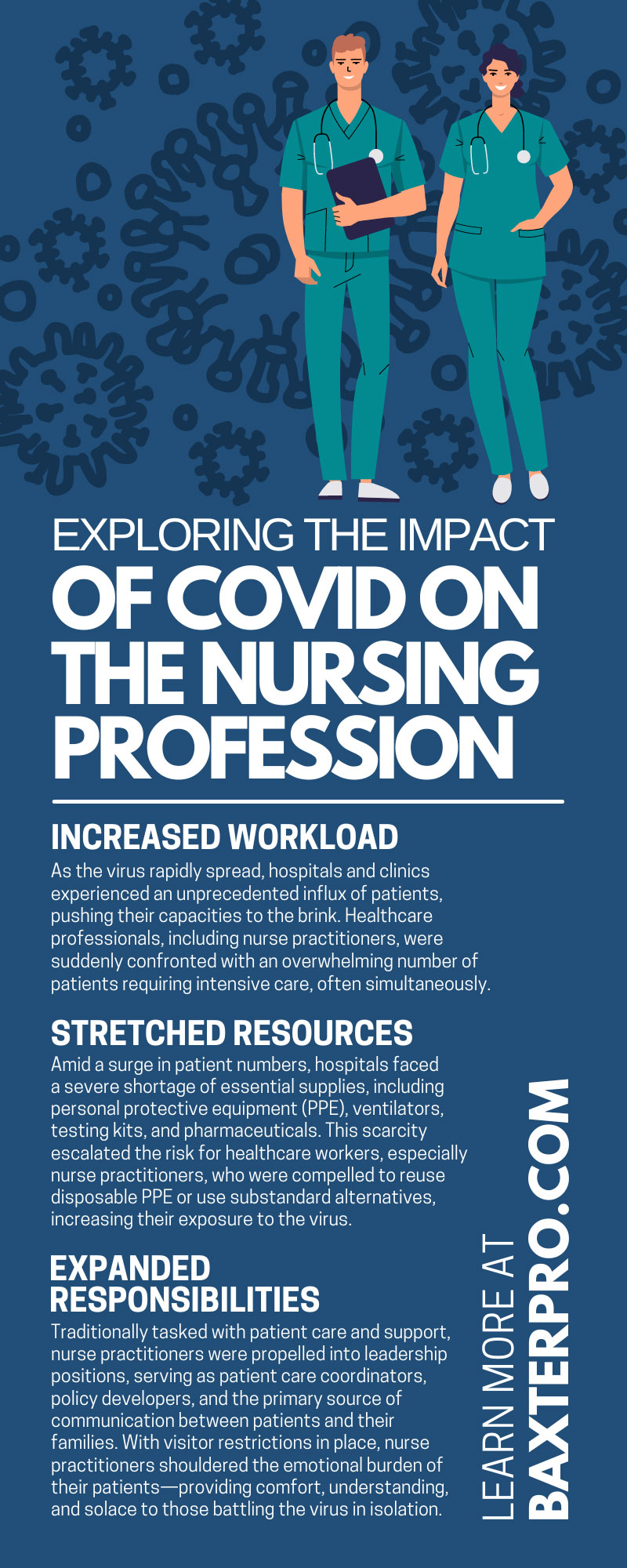
Exploring the Impact of COVID on the Nursing Profession
Mar 11 2024The COVID-19 pandemic has undeniably reshaped the landscape of the global healthcare industry, with the nursing profession at the epicenter of this transformation. The pandemic highlighted the critical role that nurse practitioners play as pivotal conduits of health information and patient advocacy.
During the pandemic, nurse practitioners found themselves at the frontline of the battle against COVID-19. Below, we’ll explore the impact of COVID-19 on the nursing profession, the challenges nurse practitioners faced, the issues in the industry it highlighted, and the lessons learned from the pandemic.
How COVID Strained Healthcare Workers
Understanding the broader strain that the pandemic imposed on the entire North American healthcare industry is essential to fully comprehend the impact of COVID-19 on the nursing profession.
Increased Workload
The COVID-19 pandemic marked a significant increase in workload for healthcare facilities across the United States. As the virus rapidly spread, hospitals and clinics experienced an unprecedented influx of patients, pushing their capacities to the brink. Healthcare professionals, including nurse practitioners, were suddenly confronted with an overwhelming number of patients requiring intensive care, often simultaneously.
Stretched Resources
The COVID-19 pandemic also considerably stretched the resources of North American healthcare systems. Amid a surge in patient numbers, hospitals faced a severe shortage of essential supplies, including personal protective equipment (PPE), ventilators, testing kits, and pharmaceuticals. This scarcity escalated the risk for healthcare workers, especially nurse practitioners, who were compelled to reuse disposable PPE or use substandard alternatives, increasing their exposure to the virus.
Expanded Responsibilities
The COVID-19 pandemic necessitated an expansion of roles and responsibilities for healthcare professionals, with nurse practitioners experiencing significant shifts in their scope of practice. Traditionally tasked with patient care and support, nurse practitioners were propelled into leadership positions, serving as patient care coordinators, policy developers, and the primary source of communication between patients and their families. With visitor restrictions in place, nurse practitioners shouldered the emotional burden of their patients—providing comfort, understanding, and solace to those battling the virus in isolation.
How the Pandemic Exacerbated Existing Issues in Nursing
Personnel Shortage
The COVID-19 pandemic further amplified the existing problem of understaffing in nursing. Before the pandemic, the healthcare industry was already grappling with a looming nursing shortage due to an aging workforce and a rising demand for healthcare services. As the virus spread and patient numbers surged, the strain on the limited pool of nurse practitioners increased dramatically.
Insufficient Compensation
Even before the pandemic, low pay was a significant concern within the nursing profession. The sudden and immense demands of the pandemic further underscored this problem. Nurse practitioners were required to work longer hours, often under hazardous conditions, and assume expanded roles beyond their traditional scope of practice. Despite the increased workload and risk, many nurse practitioners did not receive commensurate compensation. The discrepancy between the level of responsibility and risk assumed by nurse practitioners and their remuneration became even more obvious during the pandemic, leading to increased dissatisfaction and demotivation among nursing professionals.
Burnout
Even pre-pandemic, burnout—chronic physical, mental, and emotional exhaustion—was a formidable issue in the nursing profession. With the onset of COVID-19, the problem of burnout escalated dramatically. The relentless wave of COVID-19 patients, coupled with the fear of contracting the virus and spreading it to loved ones, fueled anxiety and stress among nurse practitioners. The emotional toll of witnessing unprecedented levels of illness and death, often with patients dying alone due to restrictive visitation policies, was immense. Coupled with the physical exhaustion of working in demanding, high-intensity environments while clad in uncomfortable protective gear, the pandemic significantly escalated burnout and mental fatigue in the nursing profession.
Lessons Learned from COVID’s Impact on Nursing
Investing in Nursing Resources
The COVID-19 pandemic underscored the crucial need for investing in nursing resources. An adequately staffed and well-equipped nursing workforce was shown to be central to combating the pandemic effectively. Where resources were scarce, patient care suffered, and the physical and emotional toll on nurse practitioners was high. Investment in quality education and training is urgently required to prepare future nurse practitioners for similar health crises.
Furthermore, the pandemic highlighted the need for investments in mental health resources for nurse practitioners who face significant stress and burnout risks in their roles. This investment will support nurse practitioners’ resilience and well-being, enhancing patient care quality. Experiencing COVID-19 made it abundantly clear that investing in nursing resources is vital for the strength and resilience of the healthcare system.
Evolving Role of Telehealth in Healthcare
The pandemic catalyzed the widespread adoption of telehealth in healthcare delivery. With social distancing protocols in place and hospitals overwhelmed, healthcare providers turned to telehealth as a safe and efficient method to continue providing care. Telehealth has been used for routine check-ups, mental health consultations, and even diagnosis of non-COVID-19-related ailments. As primary caregivers, nurse practitioners became the face of this digital transformation, using telehealth tools for patient education, monitoring vitals, and delivering care to patients in remote locations.
Many anticipate that telehealth will continue to play a prominent role in healthcare far beyond the end of the pandemic. It offers more flexible work arrangements for nurse practitioners, reducing burnout and increasing job satisfaction. Nurse practitioners can provide their invaluable services to a more extensive network of patients, including those in rural or underserved areas. Telehealth also reduces exposure to communicable diseases and can help manage patient loads more effectively by triaging care needs.
Importance of Nurse Practitioner Recruitment and Retention
The COVID-19 pandemic underscored the critical importance of robust nurse practitioner recruitment and retention strategies. Amid the health crisis, healthcare systems worldwide grappled with a dire shortage of nursing personnel, leading to overburdened staff, compromised patient care, and a heightened risk of virus transmission. Such strategies could include improved working conditions, mental health support, career development opportunities, and appropriate remuneration. The pandemic reiterated the importance of valuing, supporting, and retaining nurse practitioners, recognizing their central role in maintaining the health and well-being of communities.
Conclusion: Stay Protected as a Nurse Practitioner With Baxter & Associates
After exploring the impact of COVID-19 on the nursing profession, we see that the aftereffects of this health crisis will continue reverberating in the coming years. At Baxter & Associates, we commit ourselves to helping healthcare professionals like nurse practitioners and advanced practice nurses (APRN) with nurse practitioner liability and NP malpractice insurance to ensure they can do their jobs with clear focus and without worry of liability exposure. Contact our staff to receive a quote for our services today if you need malpractice insurance.




